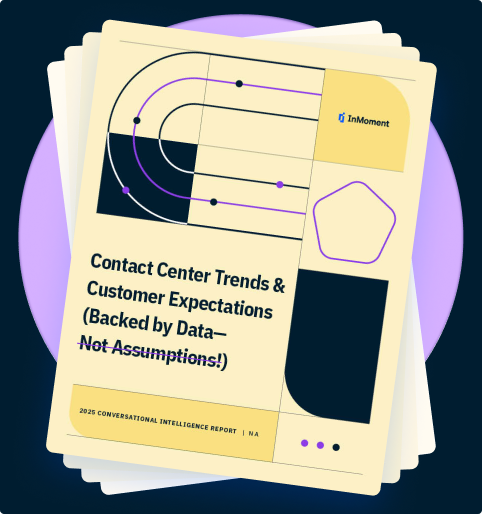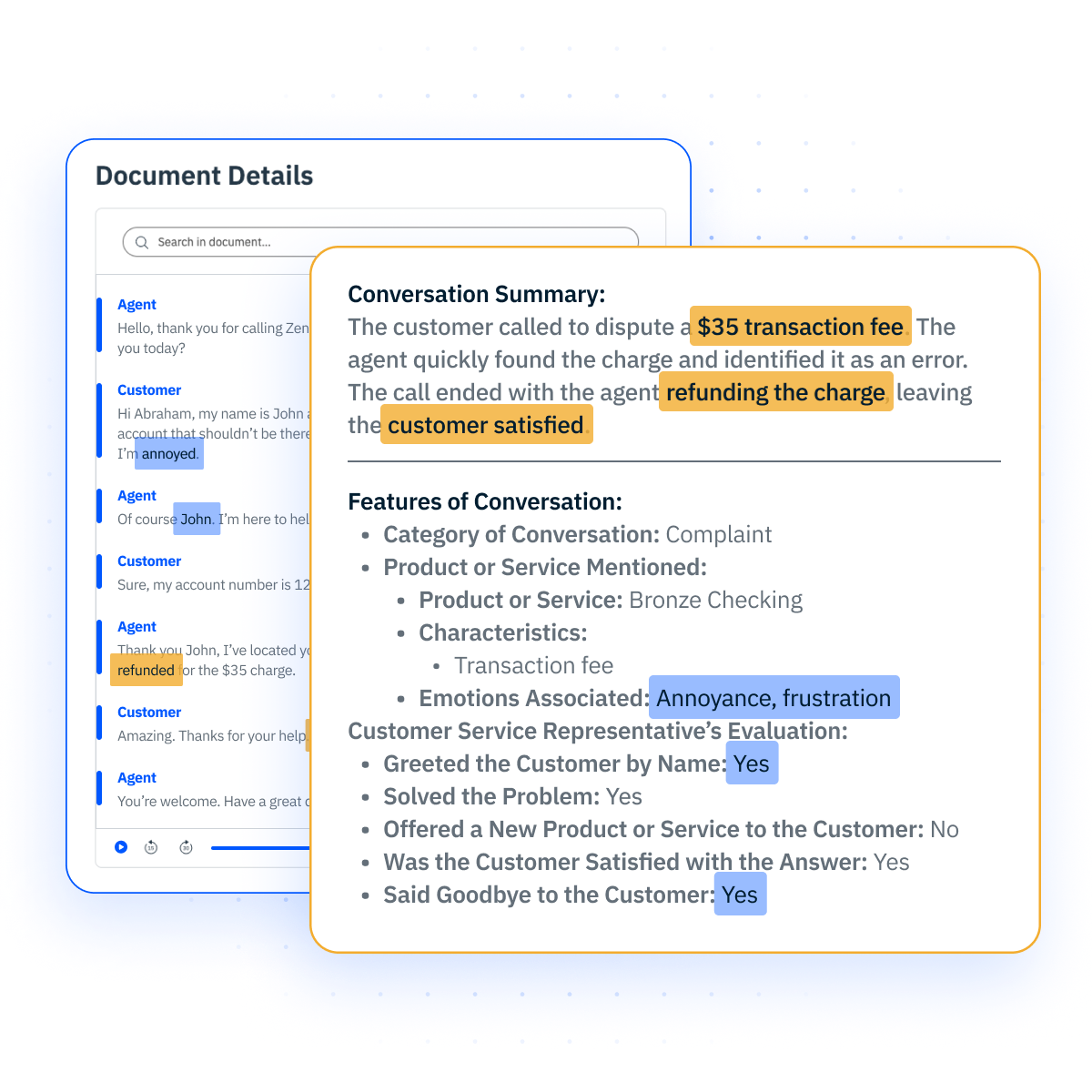Understanding Enterprise Conversational Intelligence and Its Role in CX
Discover how conversational intelligence helps enterprise CX teams scale personalization, improve agent performance, and gain customer insights.
Enterprise conversational intelligence is the use of advanced AI technologies—including natural language processing (NLP), machine learning, and speech analytics—to capture, analyze, and derive insights from customer conversations across channels. It turns call center recordings, chat logs, emails, and other dialogue data into a rich source of CX intelligence.
In large organizations, CI is used to:
- Monitor customer interactions at scale
- Uncover emerging issues in real time
- Ensure regulatory compliance
- Evaluate agent performance
- Drive operational improvements
Unlike traditional analytics that sample a fraction of interactions, enterprise CI can process and evaluate 100% of conversations—providing a complete picture of customer sentiment, behavior, and intent.
Why conversational intelligence matters for enterprise CX
Customers expect you to get it—to know who they are, what they’ve asked before, and how to help them without them having to repeat themselves over and over.
If you’re not listening properly, you’re flying blind. You might miss pain points, fail to spot early signs of churn, or leave your service team dealing with the same issues again and again.
For enterprises handling millions of interactions per year, this level of service can’t be achieved through manual methods alone. CX leaders need scalable tools that can:
- Identify patterns and issues in real time
- Empower proactive service improvements
- Align teams around shared insights
Conversational intelligence bridges the gap between raw data and meaningful action. It allows enterprises to shift from reactive customer service to proactive experience improvement—spotting issues before they escalate, optimizing agent workflows, and uncovering what really matters to their customers.
Benefits of conversational intelligence for enterprise businesses
Let’s take a closer look at how enterprise conversational intelligence delivers measurable impact across large CX teams.
For large organisations, this isn’t just a “nice to have”—it’s essential. With thousands of agents handling high interaction volumes, operational inefficiency can quickly become costly. Conversational intelligence streamlines workflows by:
- Automating quality assurance across all conversations
- Flagging process bottlenecks and recurring customer friction
- Replacing manual review with real-time issue detection
This means fewer hours spent on repetitive monitoring and more time focused on delivering value—boosting team productivity and reducing overall cost to serve.
Driving measurable improvements in CSAT, NPS, and resolution time
CI tools provide detailed insights into what customers are experiencing—helping teams:
- Shorten average handle times
- Personalize service based on conversation history
- Improve first-contact resolution rates
The result? Higher Customer Satisfaction (CSAT), improved Net Promoter Score (NPS), and more loyal customers who feel heard and valued.
Empowering CX leaders with real-time dashboards and trend analysis
Executives and team leaders need more than just data—they need clarity. Enterprise CI platforms offer:
- Customizable dashboards with real-time metrics
- Trend analysis that reveals shifts in sentiment or service gaps
- Drill-down capabilities to explore specific calls or agents
These tools enable data-driven decision-making that’s fast, confident, and impactful.
Multichannel support to provide a holistic view of the customer journey
Customers don’t think in channels—they think in experiences. CI tools that span voice, chat, email, and messaging:
- Consolidate conversations into unified customer profiles
- Enable seamless, context-aware interactions
- Support consistent service across every touchpoint
This multichannel visibility empowers teams to deliver experiences that feel personal, even at scale.
Enterprise conversational intelligence applications in CX
So how exactly does conversational intelligence show up in day-to-day CX operations? Here are some of the most powerful applications across the enterprise.
Unified visibility across every support channel
InMoment’s conversational intelligence platform integrates insights from every customer interaction, no matter where it happens. That means no more silos, no more guessing.
CI technology:
- Uses AI/NLP to quality-assess 100% of interactions
- Surfaces meaningful trends across all channels
- Reveals the full story behind customer friction or success
This holistic view ensures that every decision is based on a complete, accurate understanding of the customer journey.
Rapid root cause identification to reduce failure demand
Not all customer contacts are created equal. Failure demand—contacts that arise from unresolved issues or broken processes—can inflate support volumes and costs.
Conversational intelligence helps:
- Categorize and quantify contact reasons
- Uncover systemic drivers of repeat contacts
- Reduce unnecessary demand through upstream fixes
By acting on root causes instead of symptoms, CX leaders can improve both efficiency and satisfaction.
Smarter staff development and workforce planning
CI isn’t just about customers—it’s about empowering teams. These tools support:
- Automated QA scoring and call summaries
- Skill gap analysis and targeted coaching
- Performance benchmarking across agents or regions
This means less burnout, better training, and more consistent service delivery. Managers spend less time on admin and more time developing talent.
Sentiment analysis and emotional intelligence insights at scale
Emotions matter. The ability to understand customer tone, frustration, or delight in real time helps teams:
- Defuse tense situations
- Spot emerging sentiment trends
- Tailor responses to emotional context
CI tools use advanced sentiment analysis to detect mood shifts and track emotional journeys—providing a layer of empathy at scale.
Verifiable insights that drive organizational action
CX leaders need to back up their strategies with data. Conversational intelligence gives them:
- A representative dataset (100% of conversations, not samples)
- Verifiable evidence to guide cross-functional improvements
- Clear, defensible insights to present to executive stakeholders
This builds credibility for the CX function and ensures that strategic changes are rooted in real customer needs.
Voice of the customer (VoC) analytics to inform product and service changes
One of the most powerful things conversational intelligence can do is help you spot the recurring themes your customers are talking about—without needing to trawl through thousands of transcripts manually.
By analysing conversations at scale, Conversational Intelligence identifies the real issues (and opportunities) customers keep bringing up. Whether it’s frustration over a new feature, repeated questions about a billing process, or glowing praise for something that’s working—these insights are gold for CX and product teams.
The result? You can back up product decisions with actual customer data. You’ll spend less time guessing what needs fixing or building, and more time delivering updates your customers actually want.
QA and compliance monitoring
If you’re running a contact centre or handling sensitive interactions, quality assurance and compliance are non-negotiable. But traditional QA processes—where a small percentage of calls are reviewed manually—just can’t keep up at enterprise scale.
Conversational Intelligence automates the review process. It listens to every interaction, flags risky or non-compliant language in real time, and scores calls automatically based on your internal standards or industry regulations.
That means less risk, more consistency, and better visibility into how your team is performing—without burning out your QA staff.
Proactive customer outreach based on interaction patterns
Wouldn’t it be great to solve a problem before a customer even raises it?
Conversational Intelligence can help you do just that. By detecting patterns in customer behaviour—like repeated confusion, rising frustration, or signs that someone might be about to churn—CI gives your teams the early warning signs they need to act.
Whether it’s sending a follow-up message, offering a personalised solution, or looping in a specialist, you can turn potentially negative experiences into loyalty-building moments.
Features to look for in enterprise conversational intelligence software
If you’re thinking about implementing Conversational Intelligence across your business, it’s important to choose the right tool. Not all platforms are created equal—especially when you’re dealing with thousands (or millions) of conversations across multiple channels.
Here are the must-have features to look for in an enterprise-ready solution:
Verifiable Conversational Insights
You need to trust the insights you’re seeing. Look for tools that offer transparent, traceable insights with clear audit trails—so you can connect themes and trends back to the actual conversations that surfaced them.
Advanced Transcription Services
Accurate transcripts are the foundation of good CI. Make sure your platform can handle different languages, accents, and audio qualities—and includes speaker separation, time stamps, and punctuation.
Automated QA Scoring
Manually reviewing 2% of conversations won’t cut it. Look for systems that can automatically score every interaction against your QA framework, so you get full coverage and fair assessments.
Multichannel Support
Your customers aren’t just calling you—they’re chatting, emailing, DMing, and commenting. Your CI solution should handle all those channels and bring insights together in one view.
AI-Powered Summarisation
Save your teams time with automated summaries of long conversations. Instead of reading full transcripts, agents and managers can instantly see what happened, what was resolved, and what’s next.
AI-Powered Text Analytics
Dig deeper into customer sentiment, intent, and emotion with advanced text analytics. Great CI doesn’t just tell you what was said—it helps you understand what it means.
Integration with Existing Tools
Your CI platform should play nicely with the systems you already use—like CRM, ticketing, BI tools, and workforce management. Integration keeps everything connected and actionable.
Impact Analysis
Can you measure the change you’ve made? Impact analysis shows you how insights from conversations have improved customer satisfaction, reduced churn, or driven revenue. That’s how you prove the value of your program.
Elevate Your CX with InMoment’s enterprise-ready conversational intelligence
Your customers are already telling you what they want. It’s time to really hear them.
Enterprise Conversational Intelligence helps you listen at scale, understand in real-time, and act with confidence. If you want to deepen customer relationships, drive loyalty, and stay ahead of change, it’s one of the smartest investments you can make.If you’re ready to move beyond surface-level feedback and start making smarter, faster decisions based on real conversations, we’d love to show you how InMoment can help.





